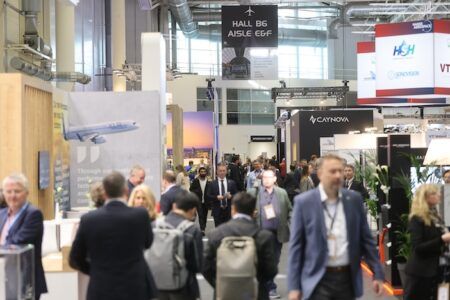3D printing or additive manufacturing (AM) is quickly becoming a ‘must have’ for aerospace & defense (A&D) manufacturers, rather than just a luxury R&D project with the A&D sector now contributing 12% of 3D printing’s GB£2 billion (US$2.86bn) global revenues. A&D companies began experimenting with 3D printing as early as 1988, and industry leaders are now starting to recognize the unique capabilities of 3D printing, searching for ways to exploit them. The US Navy is currently working on 3D manufacturing at-sea, which would revolutionize the military support chain, while in civil aviation, companies such as Boeing and Airbus have been using the process to manufacture components for more than two years.
In the future, 3D printers will allow commercial aviation manufacturers to print parts for aircraft under construction, in addition to defense manufacturers and service providers producing replacement parts for equipment damaged in-theater to support defense operations. Despite the increased uptake of 3D printing in A&D we have only glimpsed the tip of a large and growing iceberg.
Spare part required? Print one!
The complex and specialist nature of A&D equipment makes for a vast support chain. The thousands of constituent parts required to assemble an aircraft or vehicle are typically sourced from companies scattered across the globe. With strict industry safety regulations, this poses a support chain problem for A&D firms, particularly when it comes to maintenance, repair & overhaul (MRO). With ‘spares utilization’ a key to keeping assets operational for the maximum amount of time, 3D printing offers a solution.
Spare parts are prime candidates for 3D printing. Demand is hard to calculate at the best of times, as most spares must be kept in stock or within reach of procurement at short notice. Production units and spares could be produced on demand, avoiding expensive set-ups and large quantities of stock – streamlining the entire support chain.
When MRO software indicates a component is faulty or at the end of its lifespan, the availability of a replacement can effect operations. Instead of ordering in specialist parts from any given corner of the globe, 3D printing could allow A&D enterprises to ‘fly in’ the design electronically and manufacture the required part quickly, cost-efficiently and crucially on-site. With the threat of operational downtime negatively influencing revenue, 3D printing offers savings on both fronts.
The impact on ROI
One of the key inhibitors to large-scale adoption of any new technology such as 3D printing, particularly in the civil aviation sector, is perceived return on investment. 3D printing can build parts with designs and structures that help reduce the weight of a part without compromising their mechanical performance. For example, Rolls-Royce and General Electric have shown that they can produce lighter engines more quickly by incorporating 3D printing into their manufacturing processes both have announced that they will produce engine parts through AM processes over the coming years. GE Aviation recently became the first OEM to use a 3D-printed part to house its T25 sensor that provides pressure and temperature measurements for the control system, and fitted it to more than 400 of its engines currently in service.
The ROI is not difficult to see
When BAE Systems became the first company to create and use a 3D-printed part on-board a Tornado fighter jet a protective cover for the cockpit radio it made it in one day for less than GB£100 (US$140), and with a projected four-year reduction in manufacturing costs of £1.2 million (US$1.71m).
In theory, 3D printing is hugely cost-effective since there is little waste the process involves adding material rather than chipping it away. On average, the AM process generates only 5 to 10% waste material which can be recycled and reused, compared with the 90 to 95% waste from current machining a critical attribute when using expensive A&D materials. Again the ROI is plain to see.
As the technology becomes more advanced and affordable, more enterprises in the A&D sector will see the business benefits. A recent study by PricewaterhouseCooper estimated that the MRO market stands to save £2.2 billion (US$3.14bn) annually in material and logistical costs alone. The ROI is clear AM has the potential to save millions of pounds in manufacturing costs across the A&D sector.
Make it or fake it?
Comprehensive training around the use of 3D printing machines will become a necessity, alongside quality control methods when assessing components manufactured by the process. 3D printing’s ability to create complex designs and fabricate lightweight but strong structures makes it a natural fit for the A&D industry. However, product quality is the Achilles heel of every production technology, and as with all new technologies, there are issues that need to be addressed.
The threat of counterfeit parts from easily accessible 3D printers, coupled with the endless amount of designs available on the internet, could fuel a black market for counterfeit parts. OpSec, a developer of anti-counterfeiting technologies, says online libraries are starting to appear, where object files for 3D printing can be shared on a peer-to-peer basis. This has the potential to severely impact support chain costs, enabling anyone with the technology to sell counterfeit parts at a discount and leave unsuspecting businesses at risk of poorly performing and dangerous parts. A report from the Organization for Economic Cooperation and Development put the value of counterfeit goods that crossed international borders at over £160 billion (US$228bn) as far back as 2007, while the International Chamber of Commerce expects the value of counterfeit goods globally to exceed £1.1 trillion (US$1.57trn) this year.
While 3D printing is rightly being welcomed in the A&D industry, it will also require key changes in the ERP systems to control every element of the manufacturing, maintenance and support chain processes to manage the possibility of counterfeit parts entering the support chain. This is crucial in an industry as heavily regulated as A&D, where safety is paramount.
3D printing puts ERP center stage
As more A&D organizations embrace 3D printing, IT infrastructure will have to adapt and integrate and quickly. Traditional ERP solutions can take months or even years to install, let alone adapt to an entirely new production process such as 3D printing that has a dramatic and immediate effect on the support chain, safety and the whole MRO operation.
Modular, application-based ERP solutions remove the time and pain required to modify processes and make it possible to deploy new technology quickly. These agile ERP systems are far more able to accommodate new technologies such as 3D printing in a way that will allow operators to streamline the support chain, reduce time-related costs and reduce maintenance turnaround times.
Undoubtedly, 3D printing has provided the A&D industry with an enormous opportunity to make and replace parts with accuracy. The time saved when replacing parts out in the field, as well as the potential manufacturing and support chain cost savings, cannot be ignored. But in order to integrate new manufacturing processes such as 3D printing, A&D organizations need to be able to easily customize and adapt their IT infrastructure.
Agile ERP software becomes even more vital for managing MRO.
Brendan Viggers works in product and sales support at the IFS Aerospace & Defence Centre of Excellence




